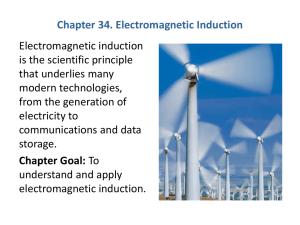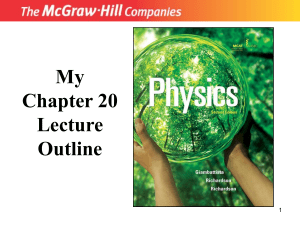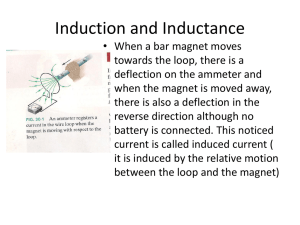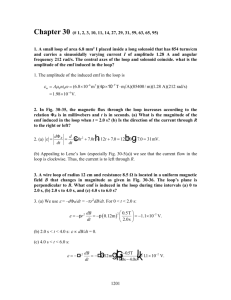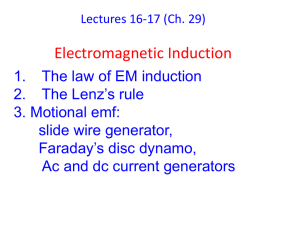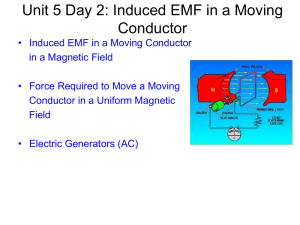PHYS 196 Class Problem 1
advertisement
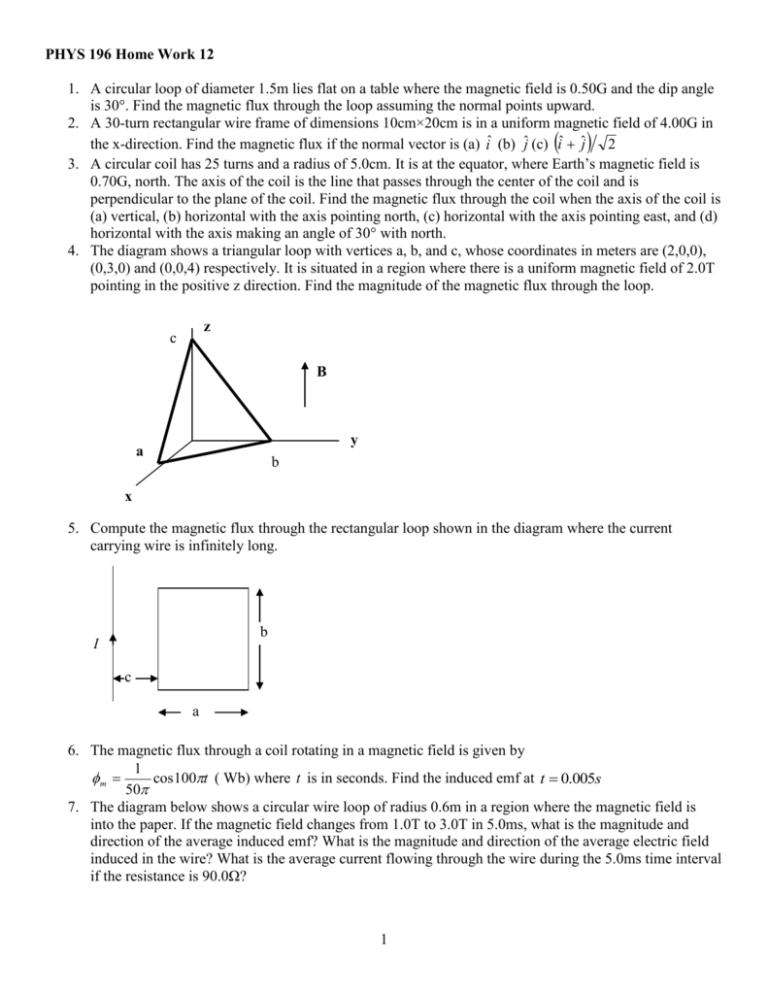
PHYS 196 Home Work 12 1. A circular loop of diameter 1.5m lies flat on a table where the magnetic field is 0.50G and the dip angle is 30°. Find the magnetic flux through the loop assuming the normal points upward. 2. A 30-turn rectangular wire frame of dimensions 10cm×20cm is in a uniform magnetic field of 4.00G in 2 the x-direction. Find the magnetic flux if the normal vector is (a) iˆ (b) ĵ (c) iˆ ˆj 3. A circular coil has 25 turns and a radius of 5.0cm. It is at the equator, where Earth’s magnetic field is 0.70G, north. The axis of the coil is the line that passes through the center of the coil and is perpendicular to the plane of the coil. Find the magnetic flux through the coil when the axis of the coil is (a) vertical, (b) horizontal with the axis pointing north, (c) horizontal with the axis pointing east, and (d) horizontal with the axis making an angle of 30° with north. 4. The diagram shows a triangular loop with vertices a, b, and c, whose coordinates in meters are (2,0,0), (0,3,0) and (0,0,4) respectively. It is situated in a region where there is a uniform magnetic field of 2.0T pointing in the positive z direction. Find the magnitude of the magnetic flux through the loop. z c B y a b x 5. Compute the magnetic flux through the rectangular loop shown in the diagram where the current carrying wire is infinitely long. b I c a 6. The magnetic flux through a coil rotating in a magnetic field is given by 1 m cos 100t ( Wb) where t is in seconds. Find the induced emf at t 0.005s 50 7. The diagram below shows a circular wire loop of radius 0.6m in a region where the magnetic field is into the paper. If the magnetic field changes from 1.0T to 3.0T in 5.0ms, what is the magnitude and direction of the average induced emf? What is the magnitude and direction of the average electric field induced in the wire? What is the average current flowing through the wire during the 5.0ms time interval if the resistance is 90.0Ω? 1 8. Referring to Problem 1, if the loop is turned upside down in 2.0s, what is the averaged induced emf? What is the total charge that has circulated through the loop during this time, assuming its resistance is 30Ω? 9. A circular coil in the plane of the paper lies in a 0.75T magnetic field pointing into the paper. If the loop’s diameter changes from 20.0 cm to 6.0cm in 0.50s, (a) what is the direction and magnitude of the average induced emf, and (b) if the coil’s resistance is 2.5Ω what is the average induced current? 10. A circular wire loop of radius r 12cm is immersed in a uniform magnetic field of B 0.500T with its plane normal to the direction of the field. If the field magnitude then decreases at a constant rate of 0.010T / s , at what rate should r increase so that induced emf within the loop is zero? 11. A 100-turn circular coil has a diameter of 2.00cm and a resistance of 50.0Ω, and the two ends of the coil are connected together. The plane of the coil is perpendicular to a uniform magnetic field of magnitude 1.00 T. The direction of the field is reversed. (a) Find the total charge that passes through a cross-section of the wire. If the reversal takes 0.100s, find (b) the average current and (c) the average emf during the reversal. 12. In a circular region, there is uniform magnetic field pointing into the page. An xy coordinate system has its origin at the circular region’s center. A free positive charge Q=1.0μC is initially at rest at a position x 10cm on the x-axis. If the magnitude of the magnetic field is now decreased at a rate of 0.10T / s , what force (magnitude and direction) will act on Q? y \ y Q=1μC x x=10cm 13. The diagram shows a small circular loop concentric with a large circular loop. A current flows in the large loop in the counterclockwise direction, and is diminishing. Use Lenz law to determine the direction of the induced current in the small loop. 2 14. If the current in the large loop of the previous problem remains steady but the small loop is lifted out of the paper, what is the direction of the induced current? 15. A 30.0-cm-long rod moves steady at 8.00m/s in a plane that is perpendicular to a magnetic field of 500G. The magnetic field is directed into the paper. The velocity of the rod is to the right. Find (a) the magnitude and direction of the magnetic force on an electron in the rod, (b) the electrostatic field in the rod, and (c) the potential difference between the ends of the rod. v 16. In the diagram, the magnetic field is 0.80T, the rod speed is 10 m/s, rod length is 20cm, and the resistance is 2.0Ω. Find (a) the induced emf in the circuit, (b) the induced current in the circuit(including direction), and (c) the force needed to move the rod with constant velocity(assuming no friction). Find (d) the power delivered by the force found in Part (c), and (e) the rate of Joule heating in the resistor. v 17. A 10-cm by 5.0-cm rectangular loop that has a resistance equal to 2.5Ω moves at a constant velocity of 2.4cm/s through a region that has a uniform magnetic field of 1.7T directed out of the page as shown. The front of the loop enters the field region at time t 0 . Graph the flux through the loop as a function of time. (b) Graph the induced emf and the current in the loop as functions of time. Neglect any selfinductance of the loop and construct your graphs to include the interval 0 t 16s 10cm B 5cm x v 20cm 3 18. A 2.00-cm by 1.50-cm rectangular coil has 300 turns and rotates in a region that has a magnetic field of 0.400T. (a) What is the maximum emf generated when the coil rotates at 60 rev/s? (b) What must its angular speed be to generate a maximum emf of 110V? 19. The generator of a car idling at 875-rpm produces 12.4V. What will the output be at a rtotation speed of 1550 rpm assuming nothing else changes? 20. The diagram shows the edge-on view of a coil of area 2.8m2 rotating counter clockwise at 700 rev/s in a uniform magnetic field of 0.73T. Write an expression for the induced emf in the coil as a function of time, with t 0 chosen when the normal to the coil is parallel to the magnetic field. Hence find the emf when the angle between the normal and the magnetic field is 30°. n̂ B Answers: 1. 2. 3. 4. 4.42 10 5 Wb (a) 7.2 10 5 Wb, (b) 0, (c) 5.1 10 5 Wb (a0 0, (b) 1.4 10 5 Wb, (c) 0, (d ) 1.2 10 5 Wb 6.0Wb Ib a c 5. 0 ln 2 c 6. 6.28V 120V / m 5.0 A, all counter clockwise 7. 450V 8. 2.9 C 9. 0.043V , counter clockwise, 0.017 A 10. 1.2mm/ s 11. 3.14C , 31.4 A, 1570V 12. 5.0 10 9 N, down 13. CCW 14. CCW 15. 6.4 10 12 N , 0.4V / m, 0.12V 16. 1.6V , CCW , 0.8 A, 0.128 N , 1.28W , 1.28W 17. 18. 13.6V , 485rev / s 19. 2200V 20. 9000 sin( 1400t ), 4500V 4

